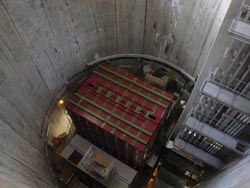New transformation of Neutrinos observed

The ND280 detector used to inspect the neutrino beam near the production point at J-PARC. The iron yoke (red) of the large magnet can be seen, which encloses the actual detector systems. The detector is located 17 meters underground and measures 7.6m x 5.6m x 6.1m. It weights about 1000 tons.<br>M. Nirkko, University of Bern<br>
The picture of the world of the inscrutable neutrinos is getting clearer: today at the European Physical Society meeting in Stockholm, the international T2K collaboration announced the definitive observation of muon neutrino to electron neutrino transformation.
In 2011 the collaboration, which includes physicists from the «Albert Einstein Center for Fundamental Physics» (AEC) of the University of Bern, announced the first indication of this process. Now this transformation is firmly established with a significance of better than 1 in 16 trillion. This is as likely as getting six correct digits in the Swiss Lottery twice in a row.
Muon-neutrinos sent and electron-neutrinos arrived
In the T2K experiment in Japan, a muon neutrino beam is produced in the Japan Proton Accelerator Research Complex, called J-PARC, located in Tokai village. The beam is aimed at the gigantic Super-Kamiokande underground detector in Kamioka, near the west coast of Japan, 295 km away. An analysis of the data from Super-Kamiokande reveals that there are more electron neutrinos in the beam from J-PARC than at there were at the start of the journey, showing that a transformation took place.
This the first time electron neutrinos were unequivocally observed in a beam of muon neutrinos. Oscillations from muon neutrinos to tau neutrinos were earlier measured by the international OPERA collaboration, where also the University of Bern contributed.
University of Bern checks particles at the production point
In order to perform such a measurement one needs to precisely study the properties of the neutrino beam at the production point. This includes the knowledge of the energy of the neutrinos, the number of electron neutrinos before the transformation and a series of additional parameters. A detector complex in Tokai was built and is operated to gain this information. The researchers from the University of Bern installed and calibrated a huge magnet, which is used to identify the particles and encloses a set of devices at 280m from the production point.
The group of Prof. Antonio Ereditato of the AEC works on the largest of these devices and the analysis of the recorded data. Besides the measurements on the neutrino beam related to the oscillation physics also the interaction of neutrinos with matter is studied in detail. This is also important for many other experiments in neutrino physics beyond the T2K experiment.
«The observation of neutrino oscillations with an appearance experiment is an important milestone in the full understanding of particle physics and cosmology in the early phase of the Universe», says Antonio Ereditato, head of the Bern group. One of the most intriguing unresolved puzzles in science is the fact that more matter than anti-matter survived after the Big Bang. Such an asymmetry was observed for quarks, however, this effect is not sufficient to resolve the puzzle.
The neutrino oscillation observed by T2K is a further step towards a fundamental understanding of the asymmetry between matter and antimatter. Further oscillation measurements could soon reveal additional information to improve the understanding of the creation of the universe. The results have wide implications for physics, according to Ereditato «the measurement of oscillations among different type of neutrinos show that the Standard Model of particle physics will have to be extended.»
The T2K-Experiment in Japan
In the T2K experiment a high energy muon neutrino beam is produced in Tokai on the east coast of Japan and aimed at the giant Super-Kamiokande detector in just under 300 km distance in the Japanese mountains. The detector measures the signals of incoming neutrinos that interact with it. «T2K» stands for «Tokai to Kamiokande». Already in 280 meter distance from the production point the beam is inspected with the Near Detector 280 (ND280). The Bern group led by Prof. Antonio Ereditato contributed significantly to the installation and analysis of the data of ND280. Further large neutrino experiments with participation from Bern are OPERA, EXO-200 and MicroBooNE.
Media Contact
More Information:
http://www.unibe.chAll latest news from the category: Physics and Astronomy
This area deals with the fundamental laws and building blocks of nature and how they interact, the properties and the behavior of matter, and research into space and time and their structures.
innovations-report provides in-depth reports and articles on subjects such as astrophysics, laser technologies, nuclear, quantum, particle and solid-state physics, nanotechnologies, planetary research and findings (Mars, Venus) and developments related to the Hubble Telescope.
Newest articles

Silicon Carbide Innovation Alliance to drive industrial-scale semiconductor work
Known for its ability to withstand extreme environments and high voltages, silicon carbide (SiC) is a semiconducting material made up of silicon and carbon atoms arranged into crystals that is…

New SPECT/CT technique shows impressive biomarker identification
…offers increased access for prostate cancer patients. A novel SPECT/CT acquisition method can accurately detect radiopharmaceutical biodistribution in a convenient manner for prostate cancer patients, opening the door for more…

How 3D printers can give robots a soft touch
Soft skin coverings and touch sensors have emerged as a promising feature for robots that are both safer and more intuitive for human interaction, but they are expensive and difficult…





















